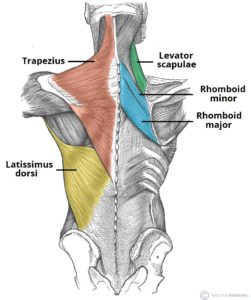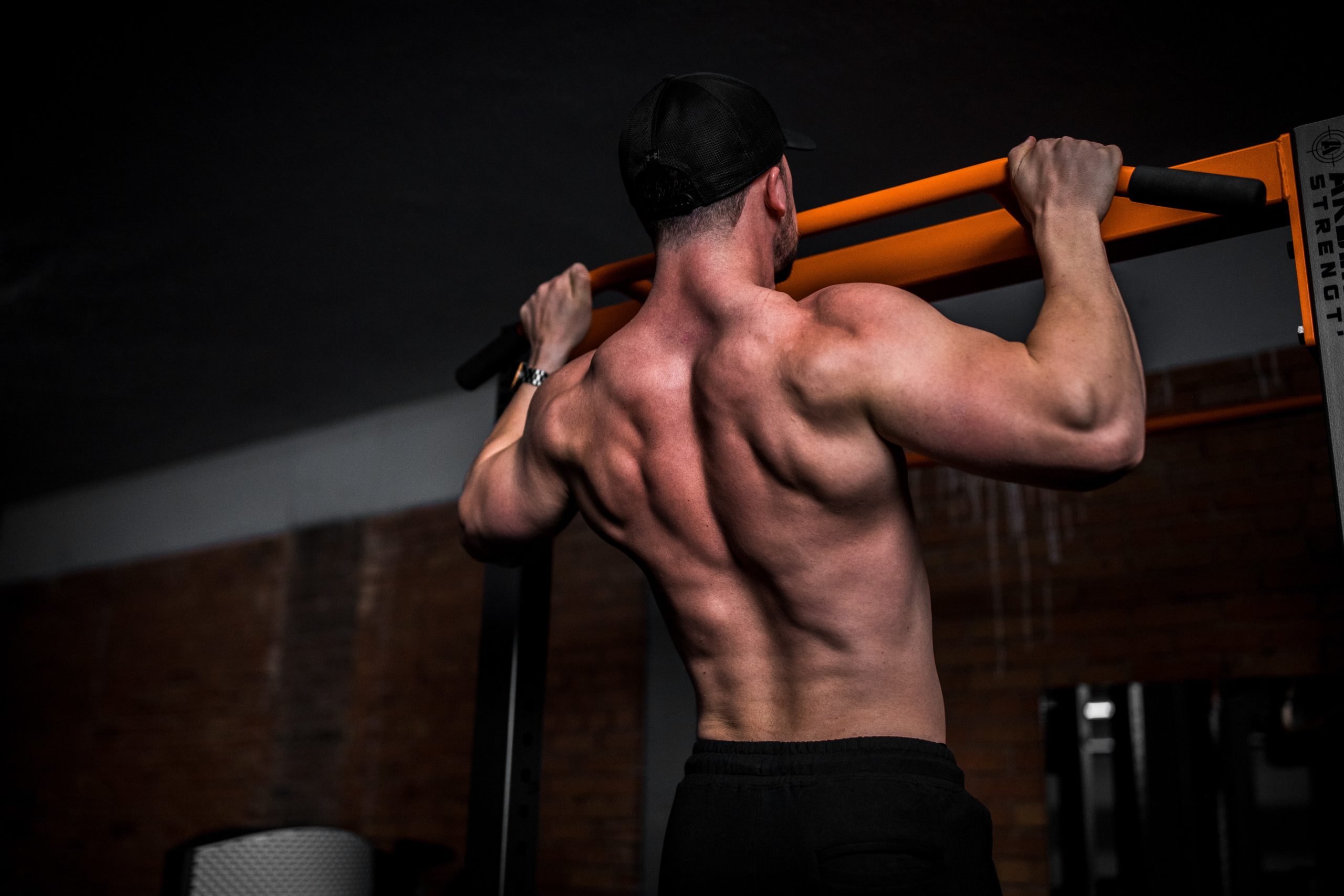Back exercises often get overlooked in the quest for a chiseled physique, but neglecting your back muscles can lead to imbalances and injury. A strong defined back can not only improve your posture but also give you that coveted V-tapered shape.
In this article, we’ll dive into the importance of back exercises, the different muscles that make up your back, with a focus on the lat muscles, and give you six effective exercises to add to your routine.
So, grab your workout shoes, get hyped, and let’s get started on building a stronger, more defined back!
The Importance of Working Out Your Back:
Your back muscles play a crucial role in supporting your daily activities and movements, making it essential to include back exercises in your workout routine. Not only do these exercises improve your posture and appearance, but they also reduce the risk of injury. Here are three key reasons why back exercises are so important.
Improved Posture
A strong back helps maintain good posture, reducing the stress placed on your neck, shoulders, and lower back. This can lead to a reduction in back pain and improved overall posture, giving you a confident and strong appearance.
Aesthetic Benefits
A well-defined back not only looks impressive but also helps create the coveted V-tapered shape. The V-tapered shape is a highly sought-after physique feature, and for a good reason. The V-taper refers to a back that is wide and muscular at the top, tapering down to a narrow waist. This creates an aesthetically pleasing hourglass shape, making the waist appear smaller and highlighting the upper body muscles.
The V-tapered shape is often associated with strength, power, and athleticism, making it a popular goal among fitness enthusiasts and bodybuilders. Building a wide, strong back is also essential for overall posture and injury prevention, as it helps support the spine and reduces stress on the neck, shoulders, and lower back.
Achieving the V-tapered shape requires a combination of diet and exercise. In addition to targeting the back muscles, especially the lats, you’ll also need to focus on reducing body fat and building the other upper body muscles, such as the shoulders, chest, and arms. By including a combination of upper back strength exercises, lower lats workout focus, cardio, and a balanced diet, you can work towards creating a defined, V-taper physique.
Injury Prevention
Back muscles are crucial for supporting the spine and preventing injury. Strengthening these muscles can help reduce the risk of injury from everyday activities, such as lifting heavy objects or playing sports.
Additionally, it can also help alleviate existing back pain by improving the stability and support of the spine.
This is How You Do Lat Pulldowns With Resistance Bands
The Different Back Muscles
The muscles of your back play a crucial role in supporting your movements and posture. Understanding the different muscles that make up your back can help you focus on specific areas and tailor your workout to your goals.
In this section, we will provide an overview of the back muscles and delve into the latissimus dorsi, or lat, muscles.
Overview of the Back Muscles
The muscles of the back can be divided into two main areas, which include the upper back and lower back. The latissimus dorsi (lats) muscles make up a large part of the back, and play a large role in it’s overall aesthetic.
Other important muscles include the trapezius (traps), rhomboids, and the levator scapulae. These muscles work together to support the spine, allowing you to perform various movements, such as lifting and twisting.
The Latissimus Dorsi (Lat) Muscles
The Lat muscles are large, flat muscles that run from the mid-back down to the hips. These muscles play a crucial role in upper body movements, such as pulling and lifting, making them an important muscle group to target when working out. Building strong lats can also help improve posture, reduce back pain, and give you a more defined appearance.
When training the lats, it’s essential to use proper form and technique to avoid injury and maximize results.

Tips for Training the Back
Training your back can be challenging, but with the right techniques and approach, you can achieve your goals and build a strong, defined back.
In this section, we will provide tips for training your back effectively, including the importance of warming up and stretching, proper form and technique, varying your upper back exercises, and gradually increasing weight.
Warm-up and stretching
Before beginning any back workout, it’s essential to warm up and stretch properly. This helps to prevent injury and improves your range of motion, making it easier to perform the exercises correctly. Muscle activation is key to being able to get a workout, effectively targeting the muscles you want.
A simple warm-up could include light cardio, stretching, and/or a few warm-up sets with lighter weights.
Proper Form and Technique
Proper form and technique are crucial when training your back to avoid injury and maximize results.
Focus on engaging the correct muscles and maintaining a stable, neutral spine throughout the exercises. It may be helpful to seek guidance from a personal trainer or fitness professional to ensure you are using the proper form.
Variation in Exercises
To avoid boredom and prevent plateaus, it’s essential to vary your back exercises.
Try incorporating different types of exercises such as pull-ups, rows, and lat pulldowns to work the back muscles from different angles. This will also help to target all the different back muscles, including the lats, traps, and rhomboids.
Increasing Weight Gradually
By gradually increasing the weight, you will be able to avoid injury and continue making progress. This is also referred to as load progression, and helps ensure you are getting stronger since you are constantly adding a little bit more weight, and pushing to go harder. Start with lighter weights and increase gradually over time, focusing on proper form and technique throughout.
It’s also essential to give your muscles time to recover between workouts, allowing them to grow and become stronger.
The 6 Best Lat Exercises
A strong, defined back is a highly coveted physique goal, and targeting the lat muscles is a key part of achieving this. The latissimus dorsi, or “lats,” are the largest muscles in the back and play a significant role in creating the V-tapered shape. Incorporating these six best lat workouts into your workout routine can help build your lats and achieve a defined, powerful back.
These exercises are designed to target the lats and surrounding muscles, providing a comprehensive workout for the back.
Whether you’re a beginner or an experienced fitness enthusiast, these good lat workouts will help you build a strong, defined back. So, grab a pair of dumbbells, hop on your favorite back workout machine, and get ready to feel the burn!
1. Lat Pulldowns
Lat pulldowns are a classic exercise that specifically targets the latissimus dorsi muscles. They are one of the best compound back exercises for building strength and definition and can be performed using a cable machine or resistance bands.
Instructions
- Start by adjusting the cable or resistance band to the appropriate height and selecting the desired weight.
- Sit down and grab the bar with a wide grip, with your palms facing away from your body.
- Engage your core and keep your back straight.
- Pull the bar down towards your chest, keeping your elbows close to your sides.
- Pause briefly at the bottom of the movement, then slowly release the bar back to the starting position.
- Repeat for the desired number of reps or until failure.
Tips
- Keep your movements slow and controlled to maximize the activation of the lat muscles.
- Maintain a stable, neutral spine throughout the exercise to avoid injury.
- Avoid using too much momentum or swinging, as this will reduce the effectiveness of the exercise.
- Focus on squeezing your lats at the bottom of the movement for maximum activation.
- Experiment with different grip widths to target the lats in different ways.
2. Dumbbell Pullovers
Dumbbell pullovers are a highly effective exercise for targeting the latissimus dorsi, or “lats.” This exercise is often overlooked, but it’s a great way to build strength and definition in the back and is one of the best lat dumbbell exercises. By using a dumbbell, you can isolate the lats and work them in a unique way, making this a great lower-back dumbbell workout to add to your back routine.
Instructions
- Start by lying flat on a bench, holding a dumbbell with both hands.
- Keep your arms extended straight up above your chest, with the dumbbell directly above your shoulders.
- Slowly lower the dumbbell behind your head, keeping your arms straight and maintaining control of the weight.
- Pause briefly when the dumbbell is just above the bench, then slowly lift it back up to the starting position.
- Repeat for the desired number of reps.
Tips
- Keep your movements slow and controlled to maximize the activation of the lat muscles.
- Avoid overextending or arching your back, as this can lead to injury.
- Maintain a neutral spine throughout the exercise to avoid straining your lower back.
- Use a weight that is challenging but manageable, and increase weight gradually as you progress.
- Focus on the stretch in the lats at the bottom of the movement, and squeeze the lats when lifting the weight back up.
3. Barbell Rows
Barbell rows are a highly effective compound exercise that targets the back muscles and latissimus dorsi, or “lats.” This exercise is a great way to build overall back strength and muscle mass, and it can be performed using a barbell or a dumbbell.
Instructions
- Start by setting up a barbell or two dumbbells with the desired weight.
- Stand with your feet hip-width apart, with a slight bend in your knees.
- Bend forward at the hips, keeping your back straight, and grasp the barbell with a grip that is just wider than your hips.
- Pull the barbell up towards your chest, keeping your elbows close to your sides.
- Pause briefly at the top of the movement, then slowly lower the barbell back to the starting position.
- Repeat for the desired number of reps.
Tips
- Keep your movements slow and controlled to maximize the activation of the lat muscles.
- Maintain a stable, neutral spine throughout the exercise to avoid injury.
- Avoid using too much momentum or swinging, as this will reduce the effectiveness of the exercise.
- Focus on squeezing your lats at the top of the movement for maximum activation.
- Experiment with different grip widths to target the lats in different ways.
4. Seated Cable Rows
Seated cable rows are popular for targeting the back muscles, especially the latissimus dorsi or “lats.” This exercise is performed using a cable machine, and it allows you to work the lats through a full range of motion.
Instructions
- Begin by setting the desired weight on the cable machine.
- Take a seat on the bench and adjust the knee pad to support your legs.
- Grasp the cable handle with both hands, using a grip that is just wider than your hips.
- Sit up straight, keeping your back neutral, and pull the cable handle towards your chest.
- Pause briefly at the top of the movement, then slowly release the handle back to the starting position.
- Repeat for the desired number of reps.
Tips
- Keep your movements slow and controlled to maximize the activation of the lats.
- Maintain a stable, neutral spine throughout the exercise to avoid injury.
- Avoid using too much momentum or swinging, as this will reduce the effectiveness of the exercise.
- Focus on squeezing your lats at the top of the movement for maximum activation.
- Experiment with different grip widths to target the lats in different ways.
5. Pull Ups
Pull-ups are a classic exercise for targeting the back muscles, mainly the lats. This bodyweight exercise requires only a pull-up bar and is a great way to build strength and definition in the back.
Instructions
- Start by hanging from a pull-up bar with a grip that is just wider than your hips.
- Engage your back and arm muscles to pull your chin up and over the bar.
- Pause briefly at the top of the movement, then lower yourself back down to the starting position.
- Repeat for the desired number of reps.
Tips
- Keep your body in a straight line throughout the movement to maximize the activation of the lats.
- Avoid swinging or kicking to generate momentum, as this will reduce the effectiveness of the exercise.
- If you are unable to perform full pull-ups, start with assisted pull-ups using a band or machine, or perform negatives (lowering yourself down slowly after jumping up to the top position).
- Experiment with different grip widths to target the lats in different ways.
- Incorporate pull-ups into your back routine regularly to see progress over time.
6. Chin Ups
Chin-ups are a variation of the classic pull-up exercise, with a slightly different grip position that emphasizes the biceps and lats. By targeting these muscles, chin-ups can help build a strong, defined back.
Instructions
- Start by hanging from a pull-up bar with your palms facing towards your body and your hands slightly closer together than your hips.
- Engage your back and arm muscles to pull your chin up and over the bar.
- Pause briefly at the top of the movement, then lower yourself back down to the starting position.
- Repeat for the desired number of reps.
Tips
- Keep your body in a straight line throughout the movement to maximize the activation of the lats.
- Avoid swinging or kicking to generate momentum, as this will reduce the effectiveness of the exercise.
- If you are unable to perform full chin-ups, start with assisted chin-ups using a band or machine, or perform negatives (lowering yourself down slowly after jumping up to the top position).
- Experiment with different grip widths to target the lats and biceps in different ways.
- Incorporate chin-ups into your back routine regularly to see progress over time.
Lat Workouts With Dumbbells
Knowing good lat exercises to do with dumbbells is especially beneficial if you are working out at home and don’t have access barbells and back machines. Another big advantage of doing lat workouts with dumbbells is that your body is being forced to also use stabilizing muscles and core muscles, as opposed to not having to worry about the movement so much when you are on a controlled back machine. The best dumbbell back exercises seem to focus on lats, and for good reason.
So, below we have a short list of some of the best lat workouts you can do with dumbbells only.
- Single Hand Dumbbell Rows – You can use a workout bench, the gym weight rack, or a random object to bend over while you lean on your hand at about a 10 to 20 degree angle. With your other hand, grasp a dumbbell and lift it up towards your stomach. You can let the weight go up and down naturally, or you can swing it slightly forward to back on the way up, and back to forward on the way down. This helps focus the movement on your lower lats.
- Bent Over Dumbbell Rows – Just like you would with a barbell, stand naturally and bend over at about a 30 to 35 degree angle. You will be using two dumbbells. Keep your back straight and lift the dumbbells up to your upper stomach. Squeeze your lats during the movement and try not to jerk your body to get the weights up. Use lighter weights in order to keep proper form.
- Dumbbell Pullovers – This is more of an advanced workout and could be modified to work the chest, but it is definitely effective in targeting the lats. Grab a single dumbbell and lay your upper back and shoulders down on a flat workout bench. Cradle the top of the weight as you lower it down behind your head, and then squeeze your lats as your slowly raise it up in an arching manner over your body.
Lower Lats Workout
When it comes down to it, targeting your lower lats is harder to do than targeting your upper lats. For upper lats, doing lat pulldowns is very effective in helping you feel the burn more towards your armpit, which is common for working out your upper lats. Working out your lower lats, however, can be much more difficult. It really requires a good mind-to-muscle connection, because you have to focus on squeezing your lower lats and working your back, instead of using your arms and mainly biceps to pull the weight.
To properly workout your lower lats, you can accomplish this with most pulling motion workout. All you need to do is focus on pulling low. Instead of doing rows, whether they are seated or otherwise, where you are pulling towards the middle of your back, which mainly works the rhomboids, keep your hands lower and focus on pulling the weight in to your stomach. This is the key to a great lower lats workout.
The Best Upper Back Exercises
While working out your lower back and lower lats is important, it’s just as important to make sure your upper back is getting the attention it deserves. The best upper back exercises don’t solely use dumbbells, barbells, or workout machines. It is a mix of all 3. Upper back strength exercises come in a wide range and variety, so we narrowed them down to a simplified list for you below:
- Dumbbell Shrugs – Grab two heavy dumbbells, stand with feet shoulder length apart, keep your legs straight, keep your arms straight, and lift/shrug your shoulders up in order to move the weights up. This motion is focusing on your trapezius muscle (traps), the one that makes your neck and shoulders look big in a t-shirt. Try to lift your shoulders up to your ears, and make sure you are squeezing your traps as you go up and down. Lower the weights down slowly for maximum results and increased TOT (Time Under Tension)
- Seated Cable Rows – You can use a cable machine and sit on the floor, or you can find a cable row machine. Sit down, grab the handle (make sure to rotate handles to switch grip positions for variation), and pull the weight towards the middle and upper middle part of your back. This is working out your Rhomboid muscles, and will give the middle-upper part of your back balance and tone. If worked enough and with the proper diet, you can grow your rhomboid muscles big, and it gives your back a cool look.
- Face Pulls – This workout is most effectively done with the cable machine using the rope grip. However, you can use a barbell (while bent-over) or exercise bands. You can sit down or stand up. The resistance used should be on the lighter side. Sit or stand with your chest and face facing either straight forward or slightly angled up. Pull the rope directly towards your face, allowing your elbows and arms to move back at about a 45 degree angle. This upper back exercise works the traps, rhomboid minor, rhomboid major, and rear deltoids (part of the shoulder/deltoid muscles).
Summing Up Your Back Workout
Whether you’re looking to improve posture, achieve a more aesthetically pleasing physique, or prevent injury, strengthening your back muscles is an important goal. Just because you can’t see your back when you look in the mirror, doesn’t mean you should ignore during your workout routine.
In this article, we’ve explored the importance of back exercises and highlighted the different muscles that make up your back, with a focus on the latissimus dorsi (lats).
We’ve also shared the best exercise for wide lats, including warm-up and stretching, proper form, variation in exercises, and gradually increasing weight.
Finally, we’ve covered six of the best lat-building exercises, including lat pulldowns, dumbbell pullovers, barbell rows, seated cable rows, pull-ups, and chin-ups.
By incorporating these exercises into your workout routine and following the tips for proper form and technique, you can build a strong, defined back that will help you look and feel your best. Remember to give yourself time to see results, listen to your body, and adjust your routine as needed. Happy lifting!
Zoppler is reader supported and may earn affiliate commissions from links on this page. We support and believe in all the products and services we promote and are affiliated with.











